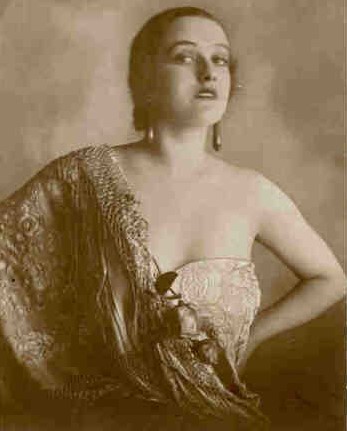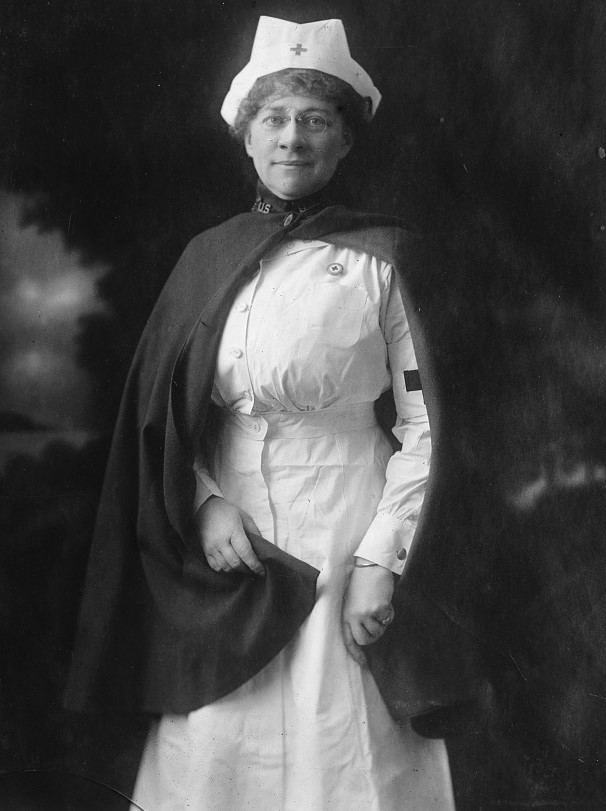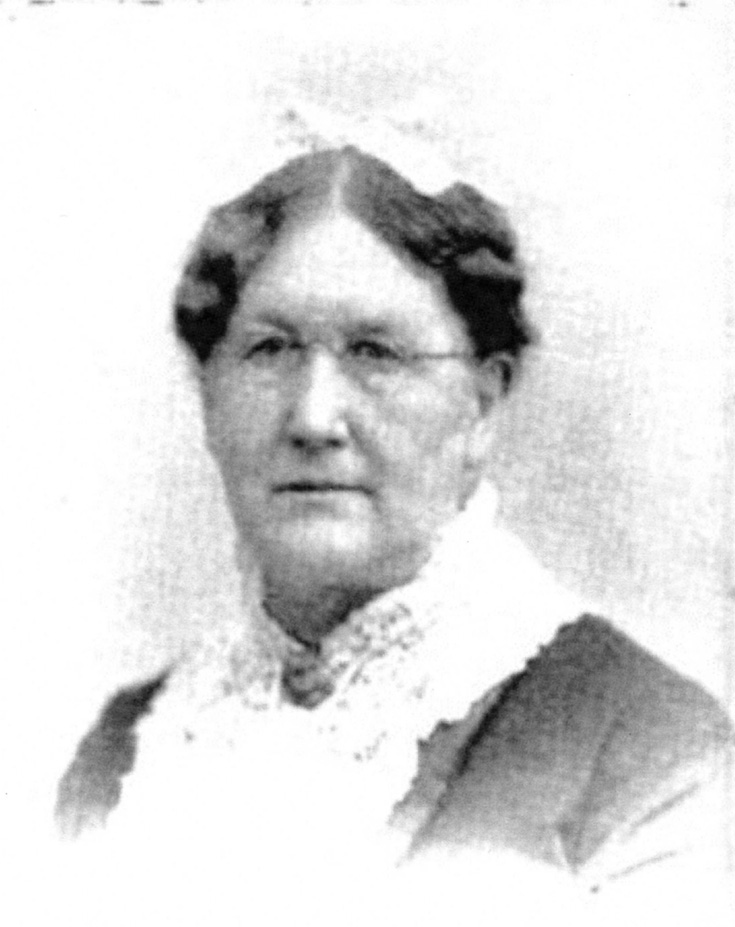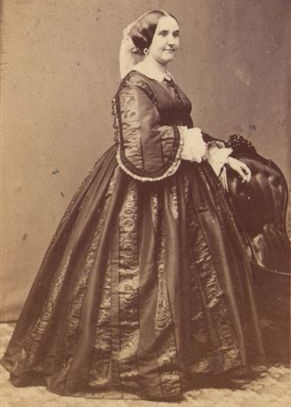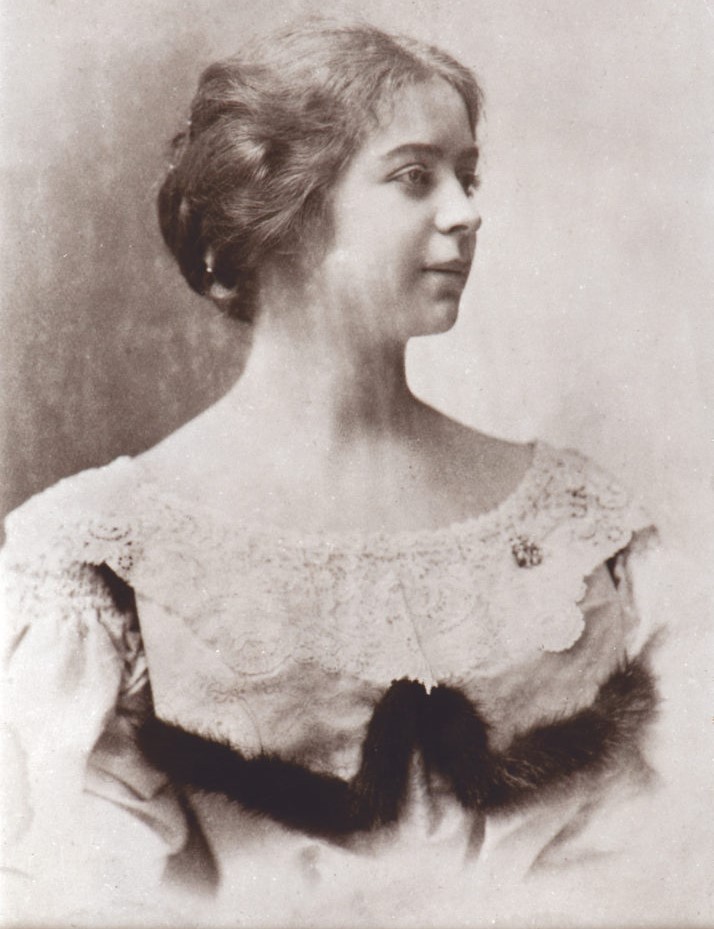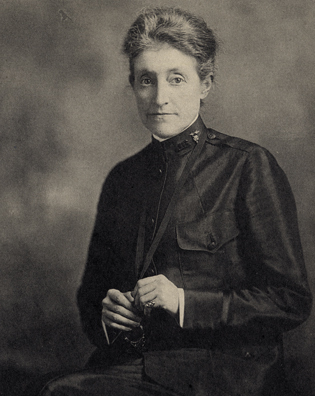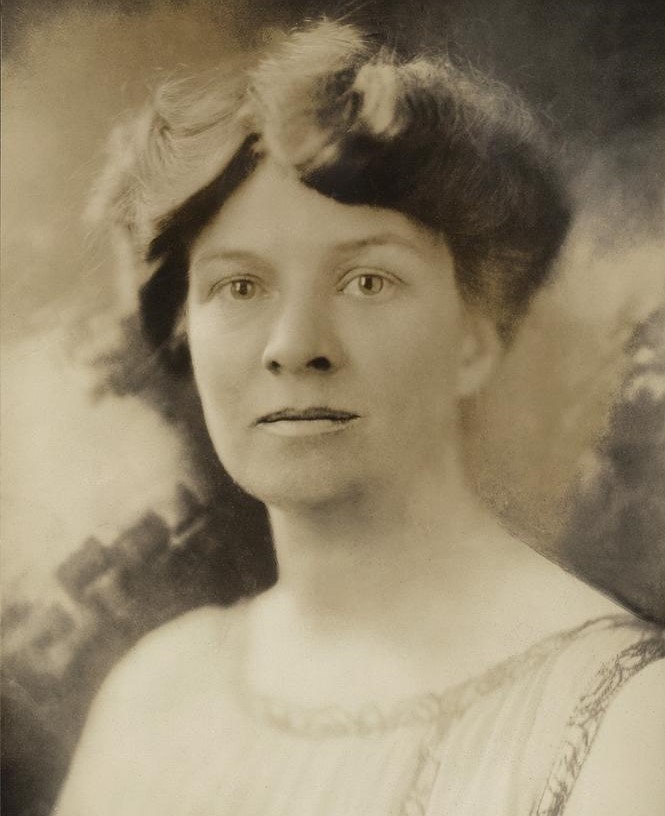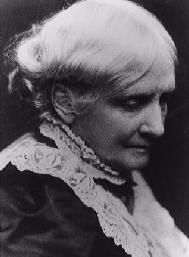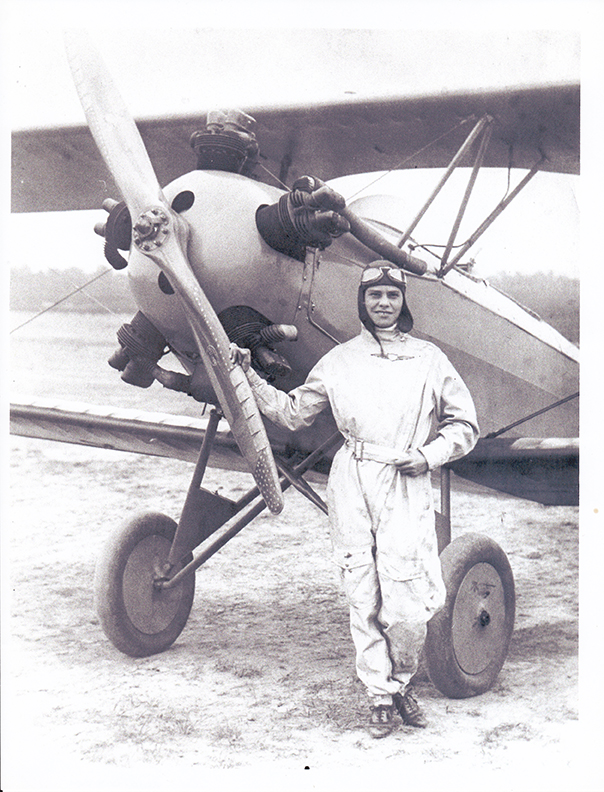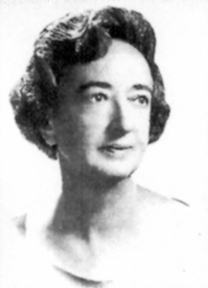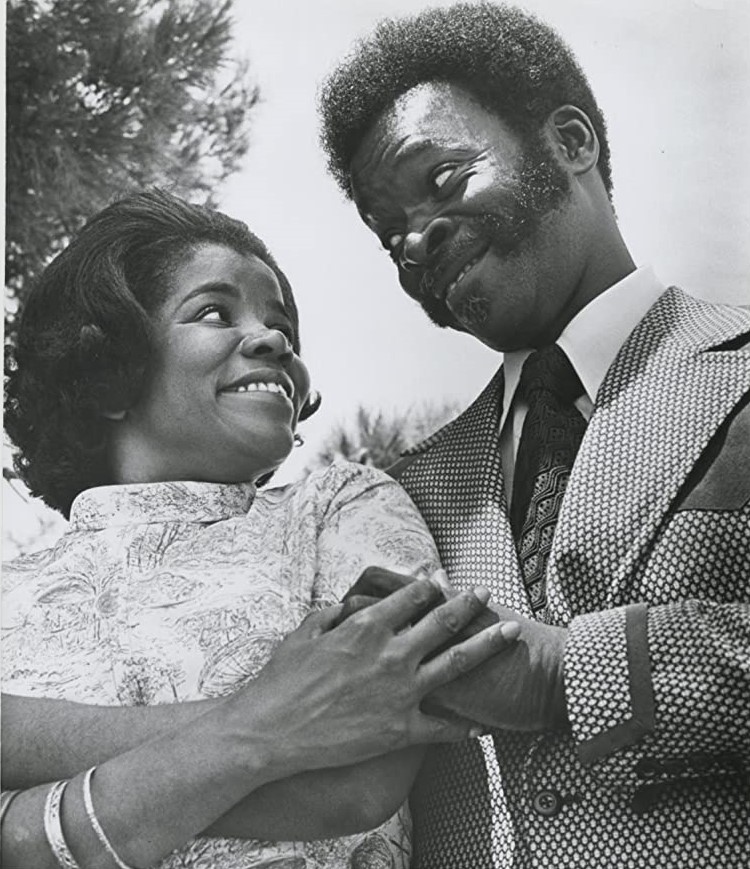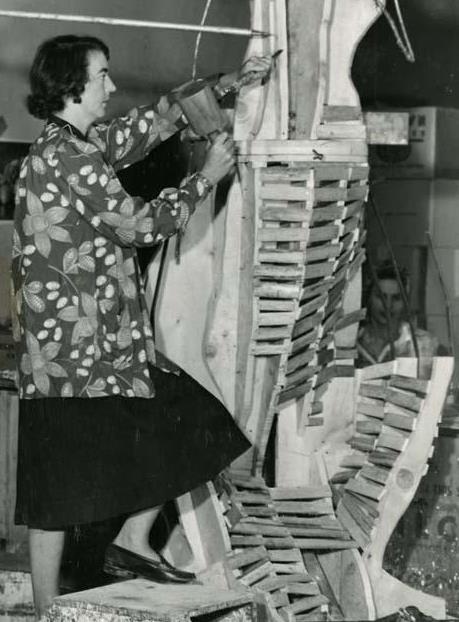Meet the extraordinary women of Cedar Hill who inspire with their stories of purpose and engagement, compassion and generosity, and strength and determination.
Fern Andra
Known as the Mary Pickford of Germany, Fern Andra was born in Watseka, Illinois.
Tightrope Walker
Andra began her entertainment career as a tightrope walker. Taught by her stepfather, aerialist Frank St. Clair, she was performing with the famous Millman Trio, a high wire and vaudeville act, by the time she was fifteen.
She headed to Europe with the Millman Trio, but eventually went out on her own as a stunt performer and actress. She received critical acclaim starring in a review in London and performed for an Austrian film company. She eventually moved to Berlin and starred in her first German silent film in 1913.
Filmmaker in Germany
When World War I broke out, Andra found herself trapped in Germany. She set up her own production company and produced more than 80 films, as well as starring in over 20 films. After the war, she remained in Germany and continued to make movies. When her career began to falter, she returned to the U.S. and worked in radio and theater. She made her last two movies in Hollywood in 1930.
Hartford Connection
In 1937, Andra came to Hartford to meet with playwright Samuel Dockrell who she eventually married in 1938. This was her fourth and final marriage as they remained married until his death in 1973. She passed away a few months later at the age of 81.
Ida Butler
Ida Butler, a graduate of Hartford Hospital School of Nursing (1901), served as head of the maternity and gynecology department of Hartford Hospital for 12 years. Beginning in 1906, she was also a Red Cross volunteer nurse with the local chapter.
The Red Cross
During World War I, she went to France with the Red Cross, serving as chief nurse at a children’s hospital. When she returned to the U.S., she was called to Washington where she organized a convalescent hospital for women in government service.
In 1919, Butler became the head of Insular and Foreign Nursing Services for the National Red Cross. The following year, she was made assistant director of the National Red Cross Nursing Service. She was promoted to director in 1936, a position she held until 1938.
Return to Hartford
Butler returned to Hartford in 1938 to reenter local volunteer work. She directed nursing services for the Connecticut State Defense Council. At the beginning of World War II, she was named head of the associate committee of nurses of the Emergency Medical Service of the Governor’s War Council. She also led the nursing recruiting committee of the Hartford Red Cross.
Awards
Butler was awarded the Florence Nightingale medal by the International Red Cross Committee of Geneva in 1937 (highest award made to members of the nursing profession), the French Reconnaissance Medal, and the Connecticut Distinguished Service Medal.
Emily Parmely Collins
Emily Parmely Collins was born in South Bristol, New York.
She was an industrious reader of history and poetry. In her teens she became a school teacher. She was very successful and was soon receiving a salary equal to that paid to male teachers.
In 1834, she married her first husband, Charles Peltier, a merchant. They lived in Michigan and had one son, Pierre. After Charles’ death, she returned home. She married Simri Collins in 1841. While living in upstate New York they had one son, Emmett Burke.
Women’s Rights Convention, Seneca Falls
In 1848, at age 34, Collins attended the Women’s Rights Convention in Seneca Falls. The Convention ignited the women’s movement and Collins became an avid supporter. She organized what is believed to be the first woman suffrage society in the world in Bristol, New York.
The South Bristol Equal Suffrage Society was a group of women who exchanged and discussed ideas. They also petitioned the legislature on important matters. They sent the first petition for suffrage to the New York State Legislature.
In 1858, Collins and her family moved to Rochester, New York. There she continued to be active in the women’s suffrage movement. She also began writing newspaper articles in support of the cause.
Civil War
During the Civil War, Collins served as a volunteer nurse in Martinsburg, Virginia.
Her son Pierre was a surgeon in the 126th NY and son E. Burke was a captain in the 21st NY Cavalry. When Burke was wounded in combat, Collins and Pierre went south to Martinsburg to tend to him.
Since Burke was too injured to be moved, they remained. There were only a handful of people, including Pierre and Collins, to look after more than 100 wounded men.
After the war, Collins moved to Louisiana. She continued to advocate for women’s right to vote. In 1879, she moved to Hartford to live with her son, Pierre Peltier.
Hartford
Collins began writing for the Hartford Journal under the pen name “Justitia.” Her columns advocated for human rights, specifically women’s rights.
In 1885, Collins collaborated with Frances Ellen Burr to organize the Hartford Equal Rights Club. Elected president, she served in this capacity until 1892. She was named honorary president for life.
She frequently spoke in front of the state legislature in support of petitions for women’s suffrage.
Elizabeth Colt
Elizabeth Hart Jarvis was the first child born to William and Elizabeth Miller Hart Jarvis. Her father was a noted Episcopal minister. Her mother was from a prominent family that included several Rhode Island royal governors as well as wealth from the West Indies trade.
Marriage to Samuel Colt
In 1856, Elizabeth married Samuel Colt who invented the Colt revolver and established Colt Armory in Hartford. Their marriage ended in 1862 when Sam died.
In the brief time they were married, Elizabeth was pregnant five times. The first two children died in infancy. At the time of Sam’s death, Elizabeth had a three-year-old son, sickly two-month-old daughter, and was pregnant with her fifth child. Ten days after Sam died, the sickly two-month-old died. The following July, Elizabeth gave birth to her final child who was stillborn.
Widowhood
When Sam died, Elizabeth was one of the richest women in the country having inherited an industrial empire. She helped manage Colt’s Patent Fire Arms Manufacturing Company from behind the scenes.
When the armory burned in 1864, it was Elizabeth who had insured the building beforehand. She managed its reconstruction, including making it fireproof and recreating the blue onion dome.
In addition to overseeing a multi-million-dollar business, Elizabeth was a prominent philanthropist and patron of the arts.
Katharine Seymour Day
Born in Hartford, Katharine Seymour Day was the daughter of prominent attorney John Calvin Day. She was also the granddaughter of suffragist Isabella Beecher Hooker and grandniece of anti-slavery novelist Harriet Beecher Stowe.
Art Education
As a child, Day studied with private tutors and attended Hartford Public High School. When she was 17, she moved to Europe with her family. While in Europe, Day’s interest in modern art blossomed. In Paris she took classes at the Atelier Moderne, learning to paint in the Neo-Impressionist and Pointillist styles.
When the family returned to the U. S. and settled in New York City, she studied under the well-known artist William Merritt Chase. She took courses at Columbia University and Union Theological Seminary. She eventually returned to Paris on her own to join the Academie Julien.
At her father’s death (1899), Day returned to New York where she lived with her mother. She continued her art education, spending summers at an art colony in Gloucester, Massachusetts.
In 1915, Day moved to California where she painted and took summer courses at the University of California – Berkeley. At Berkeley she decided that she needed a college education.
College Education
At age 47, Day returned to the east coast to enroll as a freshman at Radcliffe College. Because of her age she was accepted on a provisional basis. Majoring in psychology, she completed her undergraduate work and received a Master’s degree in only five years. A particular interest was the psychology of color and its relation to new painting techniques.
Return to Hartford
In 1924, Day purchased the Harriet Beecher Stowe House in Hartford. While living in the city she pursued her interest in painting, as well as gardening. She also continued to study. She received a graduate degree in history from Trinity College in 1936, when she was 66.
Social Activism
Day also focused her time and energy on social activism. Always politically active, she marched for women’s suffrage in New England, New York City, and London. When she was living in New York, she helped organize the efforts of the Women’s Municipal League to end the politically corrupt rule of Tammany Hall.
In Hartford, Day focused on a variety of issues. As a public health advocate, she called for an end to the open burning of garbage and the construction of city incinerators. She worked to restore the Corning Fountain in Bushnell Park and helped create the Children’s Museum of Hartford.
She was active in the effort to relocate the Wadsworth Stable from Hartford to Lebanon to save it from destruction. And she organized the Friends of Hartford to prevent the Mark Twain House from being razed for development.
Day created and generously endowed the Harriet Beecher Stowe Center. She saved not only the Stowe home, but also the house next door, and the important papers of the Beecher, Stowe, Hooker, and Day families.
Sophia Fowler Gallaudet
Sophia Fowler was born deaf at a time when there were no schools for the deaf in America and only three in the world.
In 1817, her father learned that Thomas Hopkins Gallaudet was working toward the establishment of a school for the deaf and mute. Hopeful that his daughter could attend, he took Sophia to meet Gallaudet.
When the school opened, Sophia was accepted as the fifteenth student. She studied at the school for three years. Then in 1821, Gallaudet proposed marriage. Concerned that her schooling would end, it was not until he assured that her education would continue that she agreed to marry him.
Gallaudet and Sophia were married 30 years and had eight children. In 1857, their son, Edward Miner Gallaudet, became principal of the first school for the deaf and blind in Washington, D. C. He asked his mother to move with him. She became the founding matron of the school. Sophia lived out the rest of her life in Washington.
Edith Dimock Glackens
Daughter of wealthy silk manufacturer Ira Dimock and his wife Lenna, Edith grew up in the Cornelius Vanderbilt mansion in West Hartford. After graduating from Miss Brown’s Boarding and Day School in New York, she decided to pursue a career in art. She enrolled in the Art Students League of New York and studied painting with William Merritt Chase.
Watercolor Artist
Primarily working in watercolors enhanced by gouache and black crayon, many of Edith’s paintings were character studies of women and children of the lower and middle classes. Her work was exhibited in numerous shows including the Independent Show of 1910 and the Armory Show of 1918. She also illustrated two children’s books.
Devotion to William Glackens
Edith was married to the prominent artist William Glackens for over 30 years. Grief stricken upon his death in 1938, she tragically destroyed much of her own work. She devoted herself to his legacy for the remainder of her life.
Annie Warburton Goodrich
Born in New Jersey, Annie Warburton Goodrich’s family first moved to Hartford when she was 8 years old. Six years later, they moved to England and later, France. The family returned to Hartford in 1883.
As the companion of Mrs. ASC Blake of Boston, Goodrich traveled throughout the United States and Europe. Upon her return from one of these trips, she found first her sisters and then her grandparents ill. Soon after, her father became ill and the family finances began to falter.
Nursing School
Wishing to become self-sufficient, and having observed the poor nursing care her grandfather received, Goodrich enrolled at the New York Hospital School of Nursing in 1890. She knew that nursing was a viable career for a woman during a time when few other options existed. She graduated in 1892.
Early Career
Her first job was as nursing superintendent at the New York Post-Graduate Hospital. She later served as superintendent at St. Luke’s Hospital, taught at Columbia University’s Teachers College, and served as director of the Henry Street Visiting Nurses Service.
World War I
As the U. S. entered World War I, the Surgeon General of the Army appointed Goodrich the Chief Inspecting Nurse of the Army Nurses Corps. She inspected 136 military installations prior to creating a plan for the Army School of Nursing. The War Department awarded her the Distinguished Service Medal for her work.
Nursing Education
Throughout her career, Goodrich advocated for the replacement of the then standard practical, hospital-based training with a university-based or professional-school education. In 1923, a landmark report on nursing education determined that hospital-based training program favored the needs of hospitals over the educational needs of students. Goodrich served on the committee responsible for the report.
Yale’s First Female Dean
The report led to the creation of an experimental nursing program at Yale University. In 1923, Goodrich was offered the position of dean. She was Yale’s first female dean. Over the next ten years, she developed the program into the world’s first graduate school of nursing.
Later Career
After leaving Yale, Goodrich lectured at schools and visited hospitals around the world. At the New York World's Fair in 1939, she was honored as one of the 12 outstanding women of the past 50 years. During World War II she helped organize the Cadet Nurse Corps.
Over the course of her career, Goodrich was active in local, state, national, and international nursing organizations. She served as president of the American Nurses Association and the Association of Collegiate Schools of Nursing
Goodrich was inducted into the American Nurses Association Hall of Fame in 1976.
Katharine Hepburn
Katharine Hepburn was born and raised in Hartford and West Hartford. She was the daughter of Katharine Houghton, an active supporter of women's rights, and Thomas Hepburn, Connecticut’s first urologist.
The second of six children, Hepburn was bright, independent, and an excellent athlete. She became interested in theater at an early age. At age 8, she dramatized Uncle Tom's Cabin in the tiny theater her father had built for her.
In 1924, Hepburn followed in her mother’s footsteps and attended Bryn Mawr College. After graduation, she followed her dream of becoming an actress. She began her career in the theater, first in Baltimore and then New York.
Hollywood
After the theatrical success of The Warrior’s Husband (1932), RKO pictures invited her to Hollywood. Her first film A Bill of Divorcement debuted on September 30, 1932. In 1933 she won her first Academy Award for Morning Glory. That year she also starred in Little Women, which was a huge hit.
Hepburn’s reputation for haughty behavior off-screen led to criticism. Her refusal to play the “Hollywood Game” – wearing slacks, not wearing makeup, not posing for pictures, and not giving interviews – resulted in several flops. In 1938, Bringing Up Baby and Holiday, both with Cary Grant, slightly redeemed her, but not enough to keep her from being dubbed box-office poison.
The Philadelphia Story
Hepburn revived her career by going back to the theater. In 1938, she starred in The Philadelphia Story on Broadway, receiving critical acclaim. She obtained the film rights to the play with the financial assistance of Howard Hughes. She then sold the rights to MGM with the conditions that she star in the film and retain decision making power. It was a box office hit.
Hepburn & Tracy
Hepburn’s next film was Woman of the Year in 1942. Paired with Spencer Tracy, the movie sparked their life-long affair. They starred together in nine films and sustained a relationship that lasted 25 years. Their final collaboration was Guess Who’s Coming Dinner which was also Tracy’s last film.
Academy Award Winner
Hepburn’s career spanned five decades. She holds the record for most Best Actress Oscar wins with four. In addition to Morning Glory (1933), she won for Guess Who’s Coming to Dinner (1967), The Lion in Winter (1968), and On Golden Pond (1981).
Hepburn died at the age of 96 at her home in Old Saybrook, Connecticut.
Katharine Houghton Hepburn
Born in upstate New York, Katharine Houghton was the oldest of three daughters. She graduated from Bryn Mawr College, receiving an A. B. in history and political science (1899) and a M.A. in chemistry and physics (1900).
Katharine met her husband, Thomas Hepburn, when he was a medical student at Johns Hopkins School in Baltimore. Katharine was teaching at the city's Calvert School. They married before moving to Hartford where Thomas began his medical career in urology at Hartford Hospital.
Suffragist
In 1907, after attending a lecture by British suffragist Emeline Pankhurst, Katharine became an active champion of women's rights. With a few close friends, in 1913, she organized the Hartford Equal Franchise League. In addition to votes for women, the League fought for a federal ban on child labor, pensions for mothers, and education reform.
Katharine served as president of the Connecticut Women’s Suffrage Association and was on the board of a national suffrage organization. In 1916, she appeared in a debate at Carnegie Hall with Lucy Price, an ardent opponent of women’s suffrage.
With the ratification of the 19th Amendment (1920), Katharine shifted her political focus. She became involved with the birth control movement for which she was well known.
Birth Control Advocate
In 1873, the federal Comstock Law made it illegal to sell or distribute materials that promoted contraception. Connecticut passed a state law in 1879 that banned the use of contraceptives altogether. This notorious anti-birth control law was ridiculed by Katharine as the "police-under-the-bed law."
Katharine joined her friend, Margaret Sanger, founder and leader of the American Birth Control League. For many years she served as the League’s legislative chair, speaking at rallies and before the U.S. Senate.
Isabella Beecher Hooker
Isabella Beecher was born into the prominent Beecher family. She was the daughter of Rev. Lyman Beecher and his second wife, Harriet. Her older half-sisters included the author Harriet Beecher Stowe and education reformer Catharine Beecher. Raised in Litchfield, Boston, and Cincinnati, as a teenager Isabella was sent to Catharine’s Hartford Female Seminary.
Suffragist
In 1841, Isabella married lawyer John Hooker. Her long and respected career as a suffragist was launched in his law office. Upon reading William Blackstone with her husband, Isabella came across a passage that both horrified her and transformed her life.
According to Blackstone, marriage suspended a woman’s legal standing. In the eyes of the law, a wife had no rights independent of her husband. From that moment, Isabella dedicated her life’s work to the enfranchisement and empowerment of women.
In 1869, Isabella founded the Connecticut Woman Suffrage Association, serving as its director for 36 years. She planned women’s rights conventions throughout Connecticut. She also fought for a married women’s property bill. She introduced the bill to the State Legislature for seven years until its passage in 1877.
Mary Turner Hooker
Mary Turner Hooker was born in Philadelphia, the daughter of former Hartford residents Dr. Charles & Julia Mather Turner. Educated at the Sanford School in Philadelphia, she moved to the Connecticut capital upon her marriage to Edward W. Hooker.
First Woman Legislator in Connecticut
Upon the death of her husband in 1915, Hooker was named to complete his unexpired term on Hartford’s Board of Education. Three years later, she was elected to the Board in her own right, serving for nearly twenty years.
Hooker was the first woman legislator in the state of Connecticut. She was elected a representative from Hartford in 1921 and 1925. She was a noted philanthropist, supporting Hartford Hospital, Community Chest, YMCA, Salvation Army, and other charities.
The Mary Hooker Magnet School is named for her in recognition of her efforts in promoting education in Hartford.
Mary Goodrich Jenson
Mary Goodrich Jenson grew up in Wethersfield, Connecticut. She attended Collegio Gazzola in Verona, Italy, the Katherine Gibbs School, and Columbia University.
First Female Pilot in Connecticut
In 1927, at age 20, Jenson became the first woman in Connecticut to earn a pilot’s license. She worked for the Hartford Courant as its first aviation editor. Later she became the first woman at the Courant to have a bylined column.
In 1929, Jenson was a charter member of the Ninety-Nines, an organization created to provide support for women in aviation. She piloted a Fairchild KR-21 bi-plane and made history as the first woman to fly solo to Cuba.
Jenson was the only female passenger of the Hindenburg when it flew over Hartford in 1936. She served as director of the Betsy Ross Corps, a group of female pilots organized to assist in national defense.
Jenson also worked in advertising and promotion, working for Walt Disney Productions in Hollywood for a brief time in the 1930s. At Disney, she met her husband, Carl Jenson, with whom she had two children.
The family returned to Wethersfield where Jenson served on the Board of Education, the Republican Town Committee, the Council of Social Agencies of Greater Hartford, and as President of the Women’s Association.
To learn more about Cedar Hill’s remarkable aviators, check out our Barnstormers & Aviators video.Betty Knox
Born in Hartford, Betty Knox graduated from city schools, Miss Wheeler’s School in Providence, and the Yale School of Drama.
World War II
During World War II, she opened a day care center in Charter Oak Terrace to supervise children of working mothers. This work led to her interest in city affairs. She joined the Hartford League of Women Voters.
Hartford City Council
In the 1950s & 60s, Knox served six terms on Hartford’s City Council. She was committed to urban renewal, city parks, zoning protection for residential neighborhoods, and providing opportunities to underprivileged residents.
Knox Foundation
Upon her death in 1966, Knox left $2.5 million of her nearly $4.2 million estate to the charitable foundation which she started. The funds were to be used to “create, beautify and improve parks and other areas open to use or view by the public.” Today two organizations carry on her legacy, the Betty Knox Foundation and Knox Inc.
Gertrude Lewis
In 1880, in her senior year of high school, Gertrude Lewis arranged for leading animal welfare advocate, George T. Angell, to lecture in Hartford. A lawyer and philanthropist, Angell formed the Massachusetts Society for the Prevention of Cruelty to Animals in 1868.
Connecticut Humane Society
Angell came to Hartford in November 1880 and lectured at the meeting Lewis organized. Nearly 200 people remained after his presentation to begin the process of forming a society. In April of 1881, the General Assembly granted a charter to the newly established Connecticut Humane Society.
When it was first established, the Humane Society offered protective services to children as well as livestock, wildlife, companion animals, and animals used in the workplace and in sport. When the State of Connecticut developed the Department of Children and Families in 1965, the Humane Society’s primary focus shifted to animals, specifically pets.
As Angell noted, the Society “now stands as a monument of the power of one modest but earnest schoolgirl.”
Nursing Career
Lewis finished high school in 1881. She graduated from the Hartford Hospital Training School in 1901. In that same year she was selected matron of the Litchfield County Hospital where she remained throughout her career.
Anne Tracy Morgan
Born in New York, Anne Tracy Morgan was the daughter of financier J. Pierpont Morgan and his second wife Frances Tracy Morgan. Although she grew up amidst wealth and social advantages, in her mid-twenties she became active in organizations devoted to helping others.
Women Shirtwaist Strikers
In 1903 she joined Elisabeth Marbury, Florence J. Harriman, and others in organizing the Colony Club, New York's first social club for women. Although an exclusive organization for upper class women, many Colony Club members supported the women shirtwaist strikers in 1909 and 1910. Wealthy women, including Morgan, donated much-needed funds to the strikers and eventually joined the picket line.
A Friend of France
As a friend of France, Morgan was widely honored for her devotion to the victims of both World Wars.
During World War I, she established the American Fund for French Wounded and the American Friends for Devastated France. That organization relocated the homeless, built orphanages, kindergartens, and clinics and helped to restock and equip farms. As its head, Morgan carried the major burden of the work and in 1918, was awarded the Croix de Guerre.
After the war, Morgan stayed in France to continue her work. In 1924, the French government conferred the Legion of Honor on her.
World War II
In anticipation of World War II, Morgan organized the American Friends of France in 1939. She directed the work of this group and had three relief centers ready when war broke out. She assisted in the evacuation of thousands of Belgian and French refugees from occupied to unoccupied territory.
Forced to leave the country in 1940/41, Morgan returned later to supervise postwar activities. She traveled frequently between the U. S. and France between 1945 and 1948. Ill health forced her to return to the U.S. in 1948.
Virginia Thrall Smith
Virginia Thrall Smith was educated at the Suffield Institute, Hartford Female Seminary, and Mount Holyoke Seminary. In 1857, she married William B. Smith, a tailor and clothier. They lived in Hartford and had six children, three of whom died in infancy.
City Missionary Society
In 1876, at age 40, Smith was elected missionary by the City Missionary Society.
The Society, an organization sponsored by Hartford’s six Congregational churches, was designed to aid the poor through comfort, guidance, and resources. It did so by providing food and clothing to the needy. Smith expanded Society activities by establishing a loan system whereby people could obtain small loans to meet their most pressing needs regardless of their financial status. She also organized the Women’s Sewing Class and Reading Society, the Singing School for Girls, and the Boys Club.
Free Kindergarten
Smith began to focus on assisting children, which was outside the original scope of the Society. In 1881, she started the first free kindergarten in the state. Although successful, the City Missionary Society was not large enough to continue to manage the program. As a result, the Free Kindergarten Association was formed to oversee this new schooling option. In 1885, the Association advocated for a law authorizing the establishment of kindergartens in the public schools throughout the state, which passed unanimously.
Connecticut State Board of Charities
In 1882, Smith was elected to the Connecticut State Board of Charities. She was responsible for visiting almshouses and poor farms. The conditions in which children lived at these places were deplorable. Smith lobbied the legislature to forbid the commitment of destitute children to such places.
The legislature passed an act (1883) requiring each county to establish appropriate temporary residences for dependent and neglected children. However, the act did not extend to children with permanent mental or physical disabilities.
Unwed Mothers
During this time, Smith was also actively aiding unwed mothers. She helped them find homes and care during pregnancy. And then assisted in placing the babies in appropriate foster care until they could be adopted. Smith was criticized for encouraging immoral behavior and managing "baby farms.”
Connecticut Children's Aid Society
Ultimately, the attacks resulted in Smith resigning from the City Missionary Society. She became the director of the newly-formed Connecticut Children's Aid Society (1892). Its mission was to provide homes for neglected and dependent children. Smith focused her efforts on establishing a home for “incurables.”
In 1895, Smith purchased a home in Wethersfield to care for ill and abandoned children. Not unlike today, people in the community were upset about the addition of this home in their community. In 1896, two attempts to establish similar homes in Plainville were voted down. In 1897, opponents of a similar home in Hartford argued that it was too close to the trolley line, and people riding the trolley would find the appearance of the children to be too painful.
Newington Hospital for Crippled Children
In 1898, Smith identified a location in Newington that was approved by the town to meet the needs of dependent, sick, and incurable children. The property consisted of 56 acres and was a working farm. The staff and residents utilized the farms resources by growing all their own food, including vegetables, meats, eggs, and milk. By 1901, 41 children were living on the property and a second building was needed to accommodate the children. The institution later became the Newington Hospital for Crippled Children.
Louise Stubbs (Williams)
Louise Stubbs was born in Chicago where she received her early theatrical training. She earned a Bachelor of Fine Arts from Goodman Theatre before moving to New York in 1952. During her career, she appeared in over 50 plays, television shows, and commercials.
New York Theater
Stubbs was one of a group of Black actors including Ossie Davies, Ruby Dee, Harry Belafonte, and Sidney Poitier who found it increasingly possible to work in theater in the 1950s.
In the 1960s, she was part of the cast of the American production of Jean Genet’s controversial play The Blacks. This play featured a new generation of Black performers including James Earl Jones, Maya Angelou, Louis Gossett, Jr., and Cicely Tyson.
Television & Film
In 1965 and 1966, Stubbs was one of the few Black actors to be seen regularly on American television, playing the role of Carol on the soap opera Guiding Light.
In 1971, she was cast in the role of Mama Rosie in the off-Broadway stage production of Black Girl. The movie version followed a year later.
In 1988-1991 and 1994, she played Minnie Madden on the soap opera Loving.
Frances Laughlin Wadsworth
Born in Buffalo, New York, Frances Laughlin Wadsworth began painting and sculpting at the age of seven. Her family tried to convince her to focus on painting alone, saying “sculpture was heavy and hard work for a woman.”
She didn’t listen, preferring to focus on sculpture and maintaining painting as a hobby. She studied art in Europe and also studied with the famous sculptors Gutson Borglum and Charles Eugene Tefft.
Wadsworth came to the Hartford area in 1928 when she married Robert H. Wadsworth, an executive at Travelers Insurance. They lived on a 68-acre farm in Granby.
Prominent Work
Her first major work was the life-size sculpture of Thomas Hooker that stands outside the Old State House in Hartford. No pictures of Hooker exist, so to determine what he may have looked like, she studied his character and his descendants.
Other works by Wadsworth include the memorial to the founders of the American School for the Deaf that stands in Gallaudet Square and a sculpture titled “The Safe Arrival” which was commissioned by the Travelers Insurance Company and stands at Tower Square.
Institute of Living
When the Institute of Living established a Department of Educational Therapy, Wadsworth taught painting, drawing, and sculpture to patients there. She taught for over 25 years.
Remarkable Women
Cedar Hill celebrates the centennial of the 19th Amendment by highlighting eighteen extraordinary women laid to rest in our historic cemetery.
Learn their stories by clicking the button below.
Remarkable Women
Cedar Hill celebrates the centennial of the 19th Amendment by highlighting eighteen extraordinary women laid to rest in our historic cemetery.
Learn their stories by clicking the button below.

